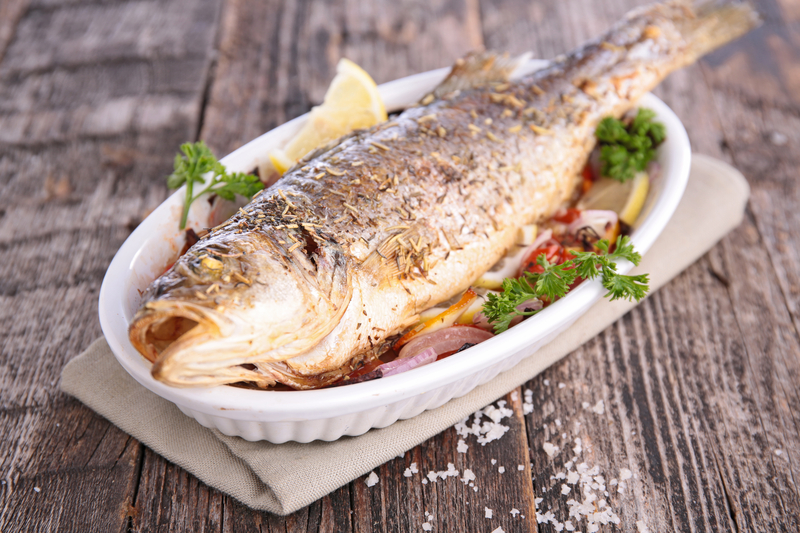 Baking fish is a delicious and healthy way to prepare this protein-packed food.
Baking fish is a delicious and healthy way to prepare this protein-packed food.
Whether you’re a seafood enthusiast or looking to incorporate more fish into your diet, understanding the rules for baking fish can help you achieve perfectly cooked, flavorful results.
In this article, we’ll delve into the essential guidelines and tips to ensure your baked fish dishes turn out mouthwateringly delicious.
Choosing the Right Fish
The first rule for baking fish begins with selecting the right type of fish.
Different varieties of fish have varying textures and flavors, and some are better suited for baking than others.
Consider the following factors:
- Fish Variety
Opt for fish with a firm and flaky texture, such as salmon, cod, haddock, tilapia, or snapper.
These varieties hold their shape well during baking.
- Freshness
Always choose fresh fish. Look for bright, clear eyes, firm flesh, and a clean, ocean-like smell.
Avoid fish with an overly fishy odor or mushy texture.
- Sustainability
Be mindful of sustainable fishing practices and choose fish that are responsibly sourced to protect marine ecosystems.
Preparing the Fish
 Before you start baking, proper preparation is key to achieving a delectable dish:
Before you start baking, proper preparation is key to achieving a delectable dish:
- Cleaning
Rinse the fish under cold water and pat it dry with paper towels to remove excess moisture.
- Seasoning
Season the fish generously with salt, pepper, and your choice of herbs and spices to enhance its flavor.
- Marinades and Sauces
Consider marinating the fish for added flavor or preparing a complementary sauce to drizzle over it before baking.
Choosing the Right Cooking Method
When it comes to baking fish, you have a few options:
- Oven Temperature
Preheat your oven to the recommended temperature, usually between 350°F to 450°F (175°C to 230°C), depending on the fish variety and recipe.
- Baking Dish
Use an oven-safe dish or a baking sheet lined with parchment paper or foil to prevent sticking and make cleanup easier.
- Baking the Fish Covered or Uncovered
Whether baking the fish covered and uncovered, it all depends on your preference and the recipe you’re following.
If you’re looking for a more tender and moist outcome or if your dish includes flavorful sauces or toppings, covering the fish may be the way to go.
Baking Time
 The rule for baking fish is to cook it until it’s done but not overdone.
The rule for baking fish is to cook it until it’s done but not overdone.
Here’s a general guideline:
- Thickness Matters
The thickness of your fish fillet or steak determines the cooking time.
As a rule of thumb, bake fish for about 10 minutes per inch of thickness.
Check for doneness by using a fork to see if it flakes easily.
- Internal Temperature
An internal temperature of 145°F (63°C) is considered safe for most fish.
Use a meat thermometer to ensure accuracy.
Avoiding Common Pitfalls
To achieve the perfect baked fish, steer clear of common mistakes:
- Overcooking
Overcooked fish can become dry and lose its flavor. Keep a close eye on the cooking time to prevent this.
- Neglecting Seasoning
Season your fish adequately to bring out its natural flavors.
- Skipping Preheating
Always preheat your oven to the recommended temperature before baking fish for even cooking.
Bottom Line – What Is the Rule for Baking Fish?
 Baking fish is a simple yet rewarding cooking technique that allows you to enjoy the natural flavors of this nutritious protein.
Baking fish is a simple yet rewarding cooking technique that allows you to enjoy the natural flavors of this nutritious protein.
By following the rules outlined in this article, you can ensure your baked fish dishes turn out delicious, moist, and perfectly cooked every time.
Remember to choose the right fish, prepare it properly, select the appropriate cooking method, monitor the baking time, and avoid common pitfalls.
With these guidelines in mind, you’ll be well on your way to becoming a master of baked fish cuisine.


